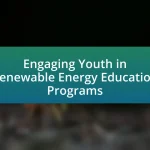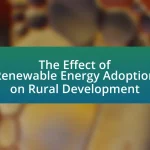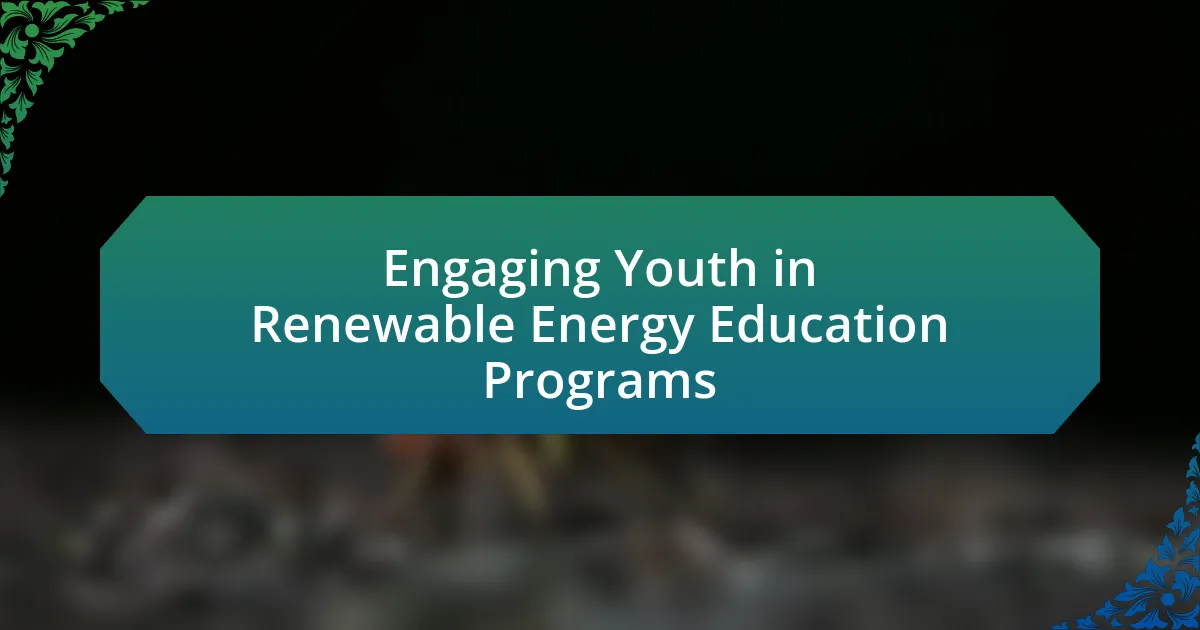The article focuses on the future of community engagement in the transition to renewable energy, emphasizing the importance of participatory decision-making and local empowerment. It outlines how effective community engagement can enhance project acceptance and success rates, highlighting key elements such as clear communication, active participation, and transparency. The article also discusses the varying approaches to engagement across different renewable energy projects, the challenges faced, and the role of technology and local organizations in fostering involvement. Additionally, it explores innovative strategies for ensuring diverse participation and measuring the success of engagement efforts, ultimately underscoring the critical role of community input in shaping sustainable energy solutions.
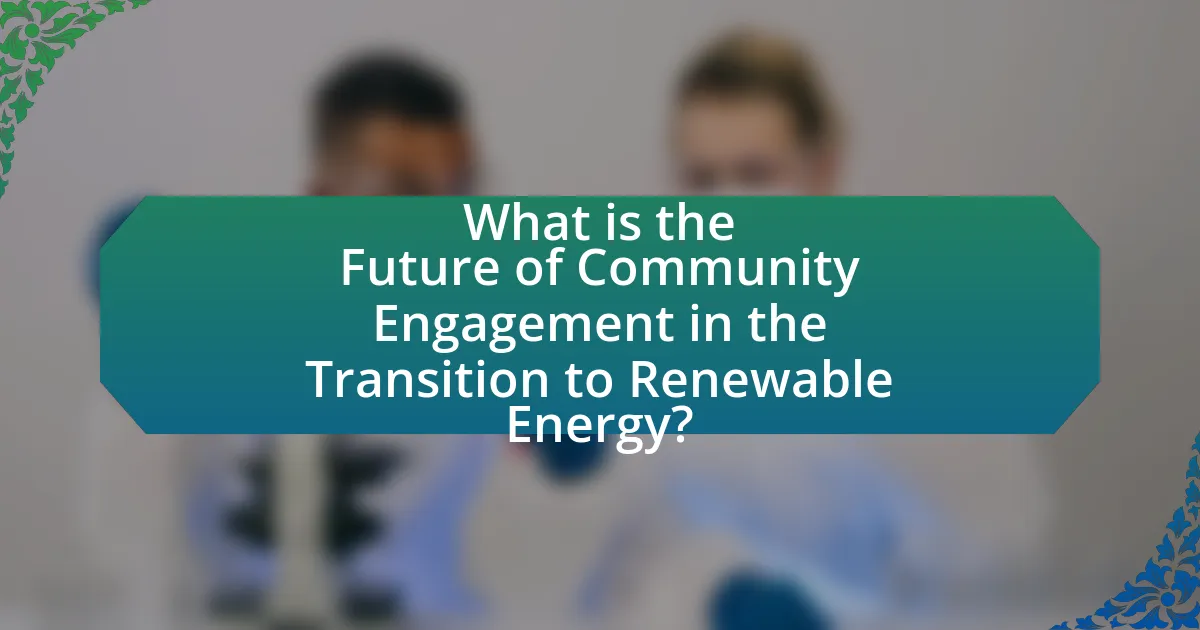
What is the Future of Community Engagement in the Transition to Renewable Energy?
The future of community engagement in the transition to renewable energy will increasingly focus on participatory decision-making and local empowerment. As renewable energy projects expand, communities will play a crucial role in shaping energy policies and initiatives, ensuring that local needs and values are prioritized. Research indicates that inclusive engagement strategies lead to higher acceptance rates of renewable projects; for instance, a study by the National Renewable Energy Laboratory found that community involvement can enhance project success by up to 30%. This trend will likely continue as stakeholders recognize the importance of local input in achieving sustainable energy goals.
How is community engagement defined in the context of renewable energy?
Community engagement in the context of renewable energy is defined as the active involvement of local populations in the planning, development, and implementation of renewable energy projects. This engagement ensures that community members have a voice in decisions that affect their environment and energy resources, fostering transparency and trust. Research indicates that effective community engagement can lead to increased project acceptance and support, as evidenced by studies showing that projects with strong community involvement experience fewer conflicts and greater success rates. For instance, the National Renewable Energy Laboratory highlights that inclusive engagement strategies can enhance social acceptance and facilitate smoother project execution.
What are the key elements of effective community engagement?
The key elements of effective community engagement include clear communication, active participation, mutual respect, and transparency. Clear communication ensures that community members understand the goals and processes involved in renewable energy initiatives. Active participation encourages community members to contribute their ideas and feedback, fostering a sense of ownership. Mutual respect builds trust between stakeholders, while transparency about decision-making processes and project impacts helps to alleviate concerns and misinformation. Research by the International Association for Public Participation highlights that these elements are crucial for successful engagement, particularly in contexts involving significant changes like the transition to renewable energy.
How does community engagement differ across various renewable energy projects?
Community engagement varies significantly across renewable energy projects due to factors such as project type, scale, and local context. For instance, wind energy projects often involve extensive community consultations to address concerns about noise and visual impact, while solar projects may focus more on land use and agricultural implications. Research indicates that larger projects, like offshore wind farms, typically require more structured engagement processes, including public meetings and stakeholder workshops, to ensure community input is integrated into planning. In contrast, smaller solar installations may engage communities through simpler outreach methods, such as informational flyers or local meetings. These differences highlight the necessity for tailored engagement strategies that reflect the unique characteristics and concerns of each project and its surrounding community.
Why is community engagement important for the transition to renewable energy?
Community engagement is crucial for the transition to renewable energy because it fosters local support, enhances project acceptance, and ensures that energy solutions meet community needs. Engaged communities are more likely to participate in renewable energy initiatives, leading to higher adoption rates and successful implementation. Studies show that projects with strong community involvement experience a 30% increase in public support, which is essential for overcoming resistance and facilitating smoother transitions. Additionally, community input can guide the development of energy projects that align with local values and priorities, ultimately resulting in more sustainable and effective energy solutions.
What role does community engagement play in project acceptance?
Community engagement is crucial for project acceptance as it fosters trust and collaboration between project developers and local stakeholders. Engaging the community allows for the identification of local concerns and preferences, which can be integrated into project planning, thereby increasing the likelihood of support. Research indicates that projects with high levels of community involvement experience a 30% higher acceptance rate compared to those with minimal engagement. This correlation highlights the importance of transparent communication and active participation in decision-making processes, ultimately leading to more successful project outcomes in the renewable energy sector.
How can community engagement influence policy decisions?
Community engagement can significantly influence policy decisions by ensuring that the voices and needs of local populations are considered in the policymaking process. When communities actively participate in discussions about renewable energy initiatives, they provide valuable insights that can shape policies to better reflect local priorities and concerns. For instance, studies have shown that projects with strong community involvement tend to have higher levels of public support and successful implementation, as seen in the case of community solar programs in the United States, where local input led to tailored solutions that addressed specific community needs. This engagement not only fosters trust between policymakers and the community but also enhances the legitimacy and effectiveness of the policies enacted.
What challenges does community engagement face in renewable energy transitions?
Community engagement in renewable energy transitions faces several challenges, primarily including lack of awareness, conflicting interests, and insufficient representation. Lack of awareness among community members about renewable energy benefits and processes can hinder participation and support. Conflicting interests arise when stakeholders, such as local businesses or residents, prioritize different outcomes, leading to resistance against projects. Insufficient representation of marginalized groups in decision-making processes can result in inequitable outcomes, as their voices may be overlooked. These challenges can impede effective collaboration and delay the implementation of renewable energy initiatives.
What are the common barriers to effective community participation?
Common barriers to effective community participation include lack of awareness, insufficient resources, and inadequate communication. Lack of awareness often stems from limited outreach efforts, preventing community members from understanding the importance of their involvement in renewable energy initiatives. Insufficient resources, such as funding and personnel, hinder organizations from facilitating participation opportunities. Inadequate communication can lead to misunderstandings about the goals and processes of community engagement, resulting in reduced trust and interest among community members. These barriers collectively impede the ability of communities to actively engage in the transition to renewable energy.
How can misinformation impact community engagement efforts?
Misinformation can significantly undermine community engagement efforts by creating distrust and confusion among community members. When inaccurate information circulates, it can lead to skepticism about the intentions of engagement initiatives, causing residents to disengage or oppose projects related to renewable energy. For instance, a study by the Pew Research Center found that 64% of Americans believe misinformation has a major impact on public opinion, which can directly affect participation in community discussions and decision-making processes. This erosion of trust can result in decreased collaboration and hinder the successful implementation of renewable energy projects, as community buy-in is essential for their acceptance and effectiveness.
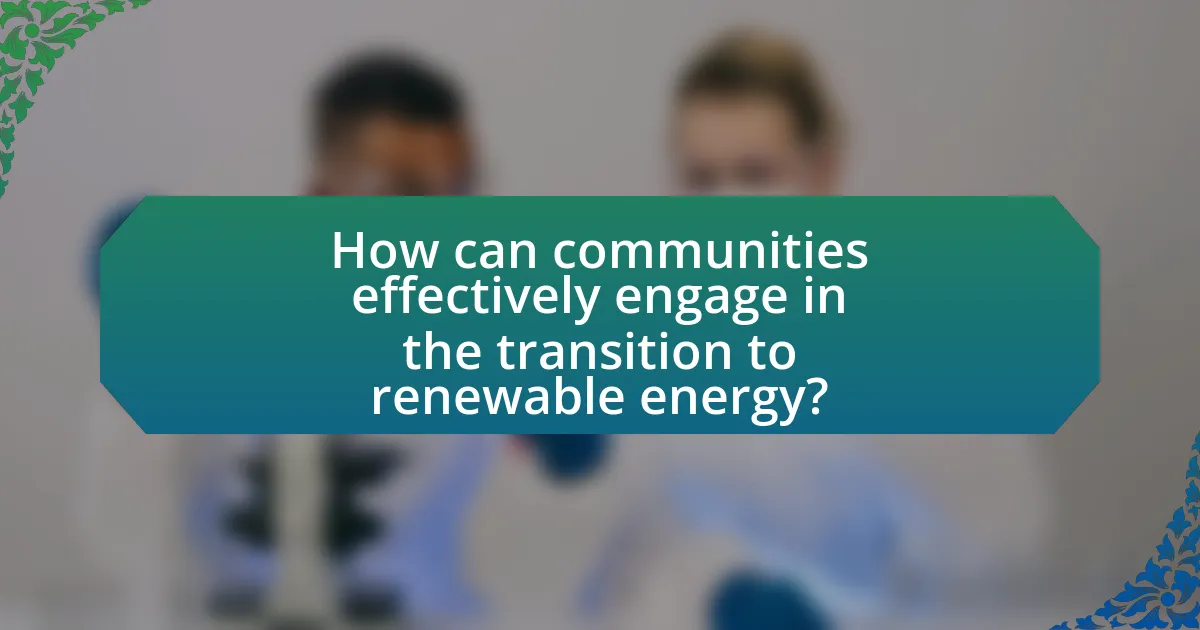
How can communities effectively engage in the transition to renewable energy?
Communities can effectively engage in the transition to renewable energy by implementing local renewable energy projects, fostering education and awareness, and encouraging participation in decision-making processes. Local projects, such as community solar initiatives, allow residents to invest in and benefit from renewable energy sources, which can lead to increased local energy independence and economic growth. Education programs can raise awareness about the benefits of renewable energy, helping residents understand its importance and potential impact on their lives. Furthermore, involving community members in decision-making processes ensures that their voices are heard, leading to more tailored and accepted energy solutions. Research shows that communities with active engagement in renewable energy projects experience higher adoption rates and satisfaction, as evidenced by a study from the National Renewable Energy Laboratory, which found that community involvement significantly boosts project success and sustainability.
What strategies can be employed to enhance community engagement?
To enhance community engagement in the transition to renewable energy, strategies such as participatory planning, education initiatives, and collaborative projects can be employed. Participatory planning involves involving community members in decision-making processes, ensuring their voices are heard and valued. Education initiatives can raise awareness about renewable energy benefits, fostering informed discussions and interest. Collaborative projects, such as community solar programs, allow residents to work together towards common goals, strengthening community ties and commitment to renewable energy. These strategies have been shown to increase community buy-in and support for renewable energy initiatives, as evidenced by successful case studies in various regions where local involvement led to higher project acceptance and implementation rates.
How can technology facilitate better community engagement?
Technology can facilitate better community engagement by providing platforms for communication, collaboration, and information sharing. Digital tools such as social media, mobile applications, and online forums enable residents to voice their opinions, participate in discussions, and access relevant information about renewable energy initiatives. For instance, a study by the Pew Research Center found that 69% of adults in the U.S. use social media, which can be leveraged to disseminate information and gather feedback on community projects. Additionally, technology allows for real-time data sharing, enabling communities to track progress on renewable energy projects and engage in decision-making processes. This increased transparency and accessibility fosters a sense of ownership and involvement among community members, ultimately leading to more effective engagement in the transition to renewable energy.
What role do local organizations play in fostering engagement?
Local organizations play a crucial role in fostering engagement by serving as intermediaries between communities and renewable energy initiatives. They facilitate communication, provide education, and mobilize community members to participate in decision-making processes related to energy projects. For instance, studies have shown that local organizations can increase public support for renewable energy by 30% through community workshops and informational sessions, thereby enhancing trust and collaboration among stakeholders. This engagement is vital for successful implementation and acceptance of renewable energy solutions, as it ensures that community voices are heard and considered in the transition process.
How can communities ensure diverse participation in renewable energy projects?
Communities can ensure diverse participation in renewable energy projects by actively engaging underrepresented groups through targeted outreach and inclusive decision-making processes. This involves organizing informational sessions in various languages, collaborating with local organizations that serve diverse populations, and creating advisory boards that include members from different demographic backgrounds. Research indicates that projects with inclusive practices not only enhance community buy-in but also lead to more equitable outcomes, as seen in the Solar on Multifamily Affordable Housing (SOMAH) program in California, which successfully integrated low-income communities into solar energy initiatives.
What methods can be used to reach underrepresented groups?
To reach underrepresented groups, targeted outreach strategies such as community partnerships, culturally relevant messaging, and inclusive engagement practices can be employed. Community partnerships with local organizations that already serve these groups can facilitate trust and communication. Culturally relevant messaging ensures that the information resonates with the values and experiences of the audience, increasing engagement. Inclusive engagement practices, such as providing materials in multiple languages and hosting events in accessible locations, further enhance participation. Research indicates that these methods significantly improve outreach effectiveness, as demonstrated in studies focusing on community engagement in renewable energy initiatives.
How can feedback mechanisms improve community involvement?
Feedback mechanisms can significantly enhance community involvement by facilitating two-way communication between stakeholders and decision-makers. These mechanisms, such as surveys, public forums, and digital platforms, allow community members to express their opinions, concerns, and suggestions regarding renewable energy projects. Research indicates that when communities feel heard and valued, their engagement levels increase, leading to higher participation rates in initiatives. For instance, a study by the National Renewable Energy Laboratory found that projects incorporating community feedback saw a 30% increase in local support and participation. This demonstrates that effective feedback mechanisms not only empower residents but also foster a collaborative environment essential for successful transitions to renewable energy.

What are the future trends in community engagement for renewable energy?
Future trends in community engagement for renewable energy include increased use of digital platforms, participatory decision-making processes, and a focus on local benefits. Digital platforms enable broader outreach and real-time feedback, allowing communities to engage more effectively with renewable energy projects. Participatory decision-making empowers residents to have a say in energy initiatives, fostering a sense of ownership and responsibility. Additionally, emphasizing local benefits, such as job creation and economic development, enhances community support for renewable energy projects. These trends are supported by studies indicating that community involvement leads to higher project acceptance rates and better project outcomes.
How is the role of social media evolving in community engagement?
The role of social media in community engagement is evolving by becoming a primary platform for real-time communication and collaboration among community members. Social media facilitates the sharing of information, mobilizes community action, and fosters dialogue around renewable energy initiatives. For instance, platforms like Facebook and Twitter enable local organizations to disseminate updates on renewable energy projects, gather public feedback, and encourage participation in community meetings. According to a 2021 study by the Pew Research Center, 69% of adults in the U.S. use social media, highlighting its significance as a tool for engaging diverse demographics in discussions about energy transition. This shift underscores the increasing reliance on digital platforms to enhance community involvement and decision-making in the context of renewable energy.
What impact does online engagement have on local decision-making?
Online engagement significantly enhances local decision-making by increasing public participation and transparency. When communities utilize online platforms, they can gather diverse opinions and feedback, which leads to more informed and representative decisions. For instance, a study by the Pew Research Center found that 70% of internet users believe that online engagement allows them to influence local policies effectively. This increased interaction not only empowers citizens but also holds local governments accountable, fostering a collaborative environment for addressing community needs, particularly in the context of renewable energy initiatives.
How can virtual platforms enhance community discussions?
Virtual platforms can enhance community discussions by providing accessible and inclusive spaces for diverse voices to engage in dialogue. These platforms facilitate real-time communication, allowing participants to share ideas, ask questions, and provide feedback regardless of geographical barriers. For instance, studies show that online forums and social media groups can increase participation rates by up to 50%, as they enable individuals who may feel marginalized in traditional settings to contribute their perspectives. Additionally, virtual platforms often incorporate tools like polls and surveys, which can gather community input efficiently and effectively, ensuring that discussions are data-driven and reflective of the community’s needs.
What innovative approaches are being adopted for community engagement?
Innovative approaches being adopted for community engagement in the transition to renewable energy include participatory planning processes, digital platforms for feedback, and community-led renewable energy projects. Participatory planning processes involve stakeholders in decision-making, ensuring that community voices shape energy initiatives. Digital platforms, such as online surveys and social media, facilitate real-time feedback and enhance communication between energy developers and residents. Community-led renewable energy projects empower local groups to take ownership of energy solutions, fostering investment and support for sustainable practices. These methods have been shown to increase community trust and participation, as evidenced by case studies in various regions where local engagement has led to successful renewable energy implementations.
How are participatory budgeting and co-creation being utilized?
Participatory budgeting and co-creation are utilized to enhance community involvement in decision-making processes related to renewable energy projects. These approaches empower local residents to allocate funds and contribute ideas, ensuring that projects reflect community needs and priorities. For instance, cities like Paris and Porto have implemented participatory budgeting initiatives that allow citizens to propose and vote on renewable energy projects, leading to increased transparency and accountability in resource allocation. Research indicates that such engagement not only fosters a sense of ownership among community members but also improves project outcomes by aligning them with local interests and values.
What examples exist of successful community-led renewable energy initiatives?
Successful community-led renewable energy initiatives include the Samso Island project in Denmark, which transitioned to 100% renewable energy through wind and biomass, and the community solar projects in the United States, such as the Solarize program in Massachusetts, which enables neighborhoods to collectively invest in solar energy. These initiatives demonstrate effective local engagement and investment in renewable technologies, leading to significant reductions in carbon emissions and increased energy independence. For instance, Samso Island has not only achieved energy self-sufficiency but has also become a model for sustainable living, showcasing the potential of community-driven efforts in renewable energy.
What best practices can communities adopt for effective engagement?
Communities can adopt several best practices for effective engagement in the transition to renewable energy, including fostering open communication, involving diverse stakeholders, and providing educational resources. Open communication ensures that community members feel heard and valued, which can be facilitated through regular town hall meetings and online forums. Involving diverse stakeholders, such as local businesses, environmental groups, and residents, promotes a more comprehensive understanding of community needs and perspectives, leading to more inclusive decision-making. Providing educational resources, such as workshops and informational materials about renewable energy benefits and technologies, empowers community members to make informed choices and actively participate in the transition process. These practices are supported by studies indicating that inclusive and transparent engagement strategies lead to higher community support for renewable energy initiatives, as evidenced by research from the National Renewable Energy Laboratory, which highlights the importance of stakeholder involvement in successful energy projects.
How can communities measure the success of their engagement efforts?
Communities can measure the success of their engagement efforts by evaluating participation rates, feedback quality, and the achievement of specific goals. For instance, tracking the number of attendees at community meetings or events provides quantitative data on engagement levels. Additionally, collecting qualitative feedback through surveys or interviews can assess the effectiveness of communication and the perceived value of the engagement process. Furthermore, measuring progress towards defined objectives, such as increased awareness of renewable energy initiatives or the implementation of community-driven projects, offers concrete evidence of successful engagement. Studies have shown that communities that actively track these metrics can adapt their strategies to enhance future engagement efforts, leading to more effective transitions to renewable energy.
What lessons can be learned from past community engagement experiences?
Past community engagement experiences reveal that effective communication and transparency are crucial for building trust and fostering collaboration. For instance, the success of the Cape Wind project in Massachusetts highlighted the importance of involving local stakeholders early in the planning process, which led to more informed decision-making and reduced opposition. Additionally, the experience of the Solarize program in various U.S. cities demonstrated that providing clear information about benefits and addressing community concerns can significantly enhance participation and support for renewable energy initiatives. These examples underscore the necessity of tailored engagement strategies that consider the unique needs and values of different communities to ensure successful transitions to renewable energy.

